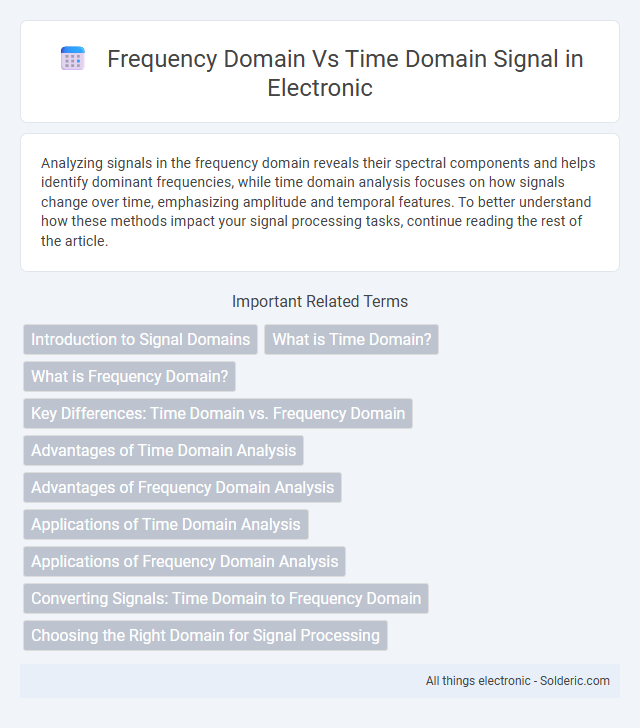Analyzing signals in the frequency domain reveals their spectral components and helps identify dominant frequencies, while time domain analysis focuses on how signals change over time, emphasizing amplitude and temporal features. To better understand how these methods impact your signal processing tasks, continue reading the rest of the article.
Comparison Table
| Aspect | Frequency Domain | Time Domain |
|---|---|---|
| Definition | Representation of signal as a function of frequency | Representation of signal as a function of time |
| Signal Analysis | Focuses on spectral components and frequency content | Focuses on amplitude variations over time |
| Tools | Fourier Transform, Spectral Analysis | Oscilloscope, Time-domain plots |
| Applications | Filter design, modulation, signal compression | Signal monitoring, transient analysis, event detection |
| Advantages | Identifies frequency components clearly | Shows how signal evolves over time |
| Limitations | Does not show when frequency components occur | Frequency content is not explicit |
Introduction to Signal Domains
Signal analysis occurs in two primary domains: time domain and frequency domain. The time domain represents the signal as it varies over time, showing amplitude changes at specific time intervals. The frequency domain, derived from transformations like the Fourier transform, illustrates the signal's spectral content, revealing the distribution of signal power across different frequencies.
What is Time Domain?
Time domain refers to the analysis of signals with respect to time, representing how signal amplitude changes over a specific duration. It provides a direct visualization of signal behavior, allowing measurement of parameters like duration, amplitude, and waveform shape. This approach is essential for understanding transient events, signal timing, and temporal patterns in various applications such as communications, audio processing, and control systems.
What is Frequency Domain?
Frequency domain represents a signal by its constituent frequencies rather than its amplitude over time, displaying how signal energy is distributed across different frequency components. It is essential for analyzing complex signals, enabling identification of periodicities and spectral characteristics using tools like the Fourier Transform. Applications in telecommunications, audio processing, and vibration analysis rely on frequency domain representation to optimize filtering, modulation, and signal reconstruction.
Key Differences: Time Domain vs. Frequency Domain
Time domain analysis represents signals as they vary over time, capturing amplitude changes at each moment, while frequency domain analysis transforms signals into constituent frequencies using methods like the Fourier Transform. Time domain is crucial for observing signal behaviors such as transient events and waveform shapes, whereas frequency domain reveals spectral content, enabling identification of dominant frequencies and filtering. Your choice between domains depends on whether temporal resolution or spectral information provides more insight for signal processing tasks.
Advantages of Time Domain Analysis
Time domain analysis provides direct insight into how signals vary over time, making it easier to observe transient behaviors, non-stationary signals, and real-time changes. It allows for straightforward interpretation of signal amplitude, duration, and waveform shape, which is crucial in applications like speech processing, control systems, and biomedical signal monitoring. Time domain techniques require less computational complexity compared to frequency domain methods, enabling faster and more efficient analysis in practical scenarios.
Advantages of Frequency Domain Analysis
Frequency domain analysis simplifies signal processing by converting complex time-varying signals into their constituent frequencies, enabling easier identification of signal characteristics such as harmonics and noise components. This approach enhances system diagnostics and filtering capabilities by allowing targeted manipulation of specific frequency bands, which is essential in applications like telecommunications and audio engineering. Frequency domain methods also improve computational efficiency for convolution and correlation operations using techniques like the Fast Fourier Transform (FFT).
Applications of Time Domain Analysis
Time domain analysis is essential for understanding signal behaviors such as amplitude changes, signal duration, and transient responses directly related to real-world phenomena, making it valuable in applications like speech processing, biomedical signal analysis, and system diagnostics. Your ability to analyze waveforms over time helps in detecting anomalies, evaluating system stability, and performing time-based filtering or modulation. These insights are critical for designing communications systems, audio engineering, and control systems where temporal accuracy impacts performance.
Applications of Frequency Domain Analysis
Frequency domain analysis is crucial in telecommunications for filtering and signal modulation, enabling efficient bandwidth utilization and noise reduction. In audio processing, it facilitates noise suppression and sound enhancement by isolating frequency components. Medical imaging techniques like MRI and CT scans leverage frequency domain transformations to reconstruct detailed images from raw signal data.
Converting Signals: Time Domain to Frequency Domain
Converting signals from the time domain to the frequency domain involves applying the Fourier Transform, which decomposes a time-based signal into its constituent frequencies. This transformation reveals the amplitude and phase of each frequency component, facilitating analysis of signal behavior and characteristics. Frequency domain representation is essential in signal processing tasks such as filtering, modulation, and spectral analysis.
Choosing the Right Domain for Signal Processing
Selecting the appropriate domain for signal processing depends on the specific application and analysis goals, with time domain offering insights into signal amplitude variation over time and frequency domain providing information on signal components and spectral content. Time domain analysis is ideal for transient, time-varying signals and capturing temporal waveforms, while frequency domain techniques, such as Fourier Transform, excel at identifying periodicities and filtering specific frequency bands. Engineers often use a combined approach, leveraging time-frequency representations like the Short-Time Fourier Transform (STFT) to optimize signal interpretation and manipulation.
Frequency domain vs time domain signal Infographic

 solderic.com
solderic.com